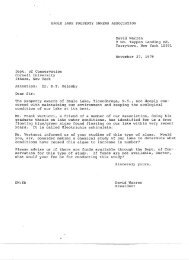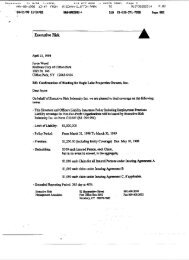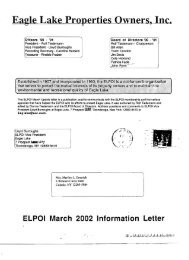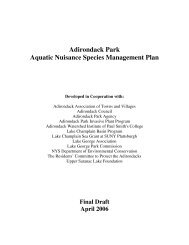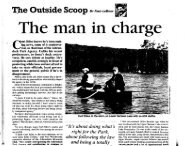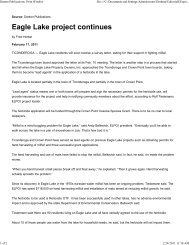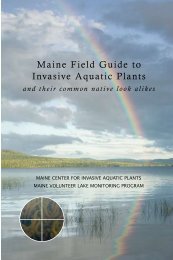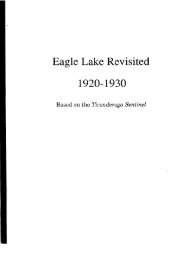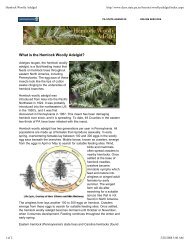Recolonization by resistant vegetation is sometimes a function of seed beds and sometimes theresult of expansion of shoreline vegetation. Najas recolonized areas previously overgrown with_Myriophyllum after the drawdown of Candlewood <strong>Lake</strong> in Connecticut (Siver et al., 1986),apparently from seeds that had been in those areas prior to milfoil dominance. Cattails andrushes are the most commonly expanding fringe species (Nichols and Shaw, 1983; WDNR,1989). Drawdowns to control nuisance submergent vegetation are usually recommended foralternate years to every third year to prevent domination by resistant plant species (Cooke et al.,1993), although drawdown may be practiced at a higher frequency to gain initial control of targetspeCIes.Recreational facilities and pursuits may be adversely impacted during a drawdown. Swimmingareas will shrink and beach areas will enlarge during a drawdown. Boating may be restrictedboth by available lake area and by access to the lake. Again, winter drawdown will avoid mostof these disadvantages, although lack of control over winter water levels can make ice conditionsunsafe for fishing or skating. Additionally, outlet structures, docks and retaining walls may besubject to damage from freeze/thaw processes during overwinter drawdowns, if the water level isnot lowered beyond all contact with structures.Carefully planned water level fluctuation can be a useful technique to check nuisancemacrophytes and periodically rejuvenate wetland diversity. Planned disturbance is always athreshold phenomenon; a little can be beneficial, while too much leads to overall ecosystemdecline. The depth, duration, timing and frequency of the drawdown are therefore criticalelements in devising the most beneficial program.With specific regard to milfoil, drawdown is known to provide some degree of control throughdrying and freezing of overwintering vegetative plant parts. Success is linked to sufficientdewatering of exposed sediments and a weather pattern that promotes drying and freezing.Control of milfoil in the drawdown zone has often been observed. Eradication has rarely beenachieved, however, mainly due to a common inability to lower the water level to the greatestdepth of milfoil occurrence.In the case of <strong>Eagle</strong> <strong>Lake</strong>, the existing outlet control is not capable of implementing a drawdownof the extent necessary to sufficiently impact the milfoil population. An annual drawdown ispracticed, and does appear to keep milfoil out of the shallowest areas, but is not able to reducemilfoil densities in deeper waters. Greater drawdown may be possible with extensive outletmodification and possible dredging, but the cost and potential disadvantages do not suggest thisas a preferred approach.D<strong>SEIS</strong> for <strong>Eagle</strong> <strong>Lake</strong> 42 ENSR
Chemical ControlsThere are few aspects of plant control which breed more controversy than chemical controlthrough the use of herbicides, which are a subset of all chemicals known as pesticides. Part ofthe problem stems from pesticides which have come on the market, enjoyed widespread use,been linked to enviromnental or human health problems, and been banned from further use. Yetas chemicals are an integral part of life and the enviromnent, it is logical to seek chemicalsolutions to such problems as infestations of non-native species which grow to nuisanceproportions, just as we seek physical and biological solutions. Current pesticide registrationprocedures are far more rigorous than in the past. While no pesticide is consideredunequivocally "safe", a premise of federal pesticide regulation is that the potential benefitsderived from use oUhveigh the risks when the chemical is used according to label restrictions.Fluridone, sold under the tradename Sonar®, is the preferred alternative for controlling largerareas of moderate to dense Eurasian watermilfoil coverage in <strong>Eagle</strong> <strong>Lake</strong>, and is discussedelsewhere. Among the variety of herbicides available today, four alternative chemicals havebeen demonstrated to be successful against Eurasian watermilfoil, although one is still anexperimental herbicide. Westerdahl and Getsinger (1988a, 1988b) provide considerablediscussion of these herbicides, much of which is summarized below.En doth allEndothall (7-oxabicyclo [2.2.1] heptane-2,3-dicarboxylic acid) is a contact herbicide acting onplant metabolism after adsorption onto outer cell membranes. Salts of endothall are marketed asAquathol K and Hydrothol 191, but only the Aquathol K formulation is typically used for milfoilcontrol. An Aquathol K concentration of 2-4 mg/l is· considered optimal for control of milfoil,but will also result in the death of many native species.Endothall acts quickly on susceptible plants, but does not kill roots with which it can not comeinto contact, and recovery. of milfoil is often rapid. Rapid death of susceptible plants can causeoxygen depletion if decomposition exceeds re-aeration in the treated area, although this can bemitigated by conducting successive partial treatments. Endothall compounds break down readilyand are not persistent in the aquatic enviroriment. Toxicity to invertebrates, fish or humans is notexpected to be a problem at the recommended dose, yet water use restrictions (i.e., 14 days) aremandated on the label.DiquatDiquat (6,7-dihydrodipyrido [1,2-a:2',1-c] pyrazinediium dibromide) is another contactherbicide. Diquat is marketed under the tradename Reward. Like endothall, it is a fast actingcontact herbicide, producing results within 2 weeks of application. It is not an especiallyselective herbicide, and can be toxic to invertebrates, fish, mammals, birds and humans.Domestic water use restrictions (i.e., 7 days) apply. Only portions of the plant with which theherbicide can come into contact are killed. Regrowth of milfoil has been rapid (often within thesame year) after treatment with diquat in many cases.D<strong>SEIS</strong> for <strong>Eagle</strong> <strong>Lake</strong> 43 ENSR
- Page 1 and 2: - -'- --:;:;;;-- -.-----.. ----- -
- Page 3 and 4: TABLE OF CONTENTSEXECUTIVE SUMMARY
- Page 5 and 6: EXECUTIVE SUMMARYEurasian watennilf
- Page 7 and 8: PROJECT SETTING AND BACKGROUND INFO
- Page 9 and 10: -....... E-~E-
- Page 11 and 12: The nuisance aquatic macrophyte .My
- Page 13 and 14: severity of the milfoil nuisance ar
- Page 15 and 16: Regional ImpactsWhen multiple lakes
- Page 17 and 18: Table 1. Eagle Lake Submersed Vascu
- Page 19 and 20: Sonar® is considered to have low t
- Page 21 and 22: leading to the recommendation that
- Page 23 and 24: However, if the treatment can be ap
- Page 25 and 26: Physical ControlsTABLE 3. MANAGEMEN
- Page 27 and 28: TABLE 3. MANAGEMENT OPTIONS FOR CON
- Page 29 and 30: TABLE 3. MANAGEMENT OPTIONS FOR CON
- Page 31 and 32: TABLE 3. MANAGEMENT OPTIONS FOR CON
- Page 33 and 34: TABLE 3. MANAGEMENT OPTIONS FOR CON
- Page 35 and 36: Benthic BarriersThe use of benthic
- Page 37 and 38: Benthic barriers have been used at
- Page 39 and 40: expected when light penetrates to t
- Page 41 and 42: undoubtedly applicable; this is a d
- Page 43 and 44: Key issues in choosing a harvester
- Page 45: Drawdo\vn has a long and largely su
- Page 49 and 50: and Getsinger, 1993) have revealed
- Page 51 and 52: A1ilfoil WeevilThe use of insects t
- Page 53 and 54: dissemination and growth with seedi
- Page 55 and 56: luegill (Leopomis macrochirus), and
- Page 57 and 58: eradicated from the system. The oth
- Page 59 and 60: depression is expected. Field tests
- Page 61 and 62: MONITORING PLANFluridone Monitoring
- Page 63 and 64: REFERENCESArnold, W.R. 1979. Flurid
- Page 65 and 66: Getsinger, K.D., GJ. Davis and M.M.
- Page 67 and 68: NaIl, L. and J. Schardt. 1980. Larg
- Page 69 and 70: Tanner, C., R. Wells and C. Mitchel
- Page 71 and 72: aterAT LAKE GEORGEBASELINE AQUATIC
- Page 73 and 74: SummaryEurasian watennilfoil (Myrio
- Page 75 and 76: Adirondack Mountains in the Hudson
- Page 77 and 78: Aquatic Plant PopulationsAquatic pl
- Page 79 and 80: Grid EnumerationThe pennanent grids
- Page 81 and 82: Diver Swimover SurveyDiver swimover
- Page 83 and 84: Daubenmire, R. 1959. A canopy-cover
- Page 85 and 86: APPENDIX I. Aquatic Plant Survey Da
- Page 87 and 88: EAGLE LAKE SONAR DEMONSTRATION PROJ
- Page 89 and 90: EAGLE L~KE SONAR DEMONSTRATION PROJ



